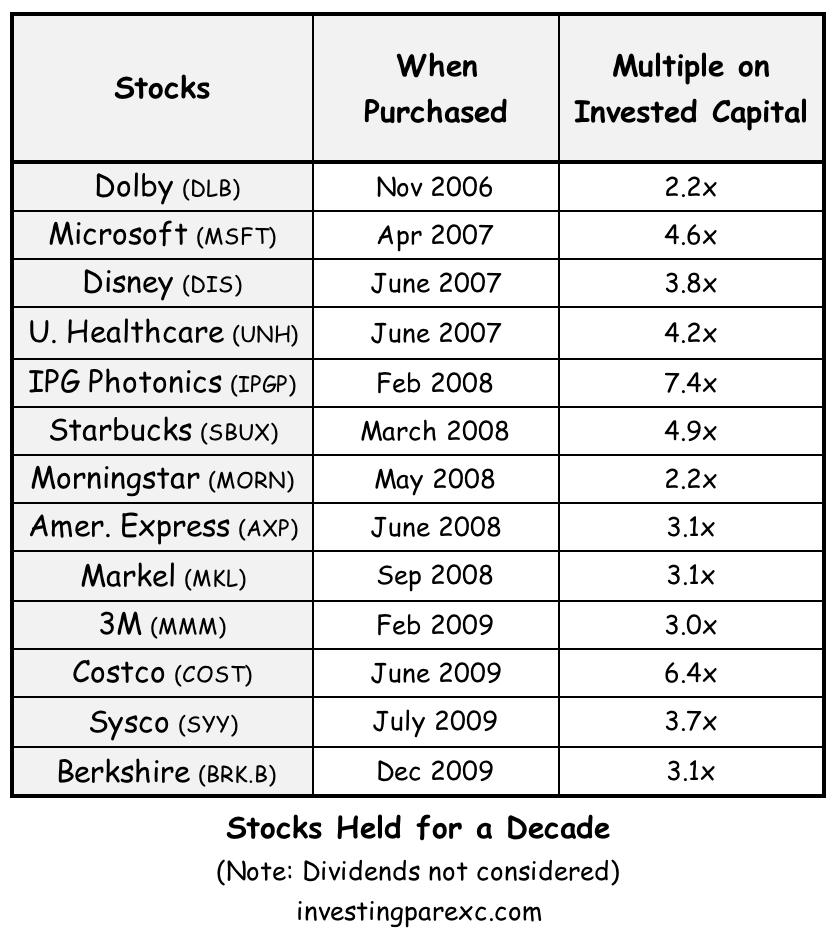
I just finished reading Chris Mayer’s book, The 100-Baggers. It’s a book about public companies whose shares have returned 100 times or more for those who held on. How long to hold on? In most cases, it took twenty years or longer.
The book is full of good insights for those who follow long-term patient investing. And even though my investing goal does not depend on finding 100-baggers, I enjoyed reading the book. The lessons in the long-term investing approach that Chris Mayer advocates in the book were still relevant.
In an early chapter of the book, Chris Mayer talks about a coffee can portfolio. This is not something he came up with—others have written about it before. The idea is to make a few well thought-out purchases today and keep them untouched for the next ten years. No matter how they do. It’s like what investors used to do in old times: Secure paper share certificates for the purchases made today, stuff them in a coffee can, put a lid on it, and store in a safe place. This coffee can is meant to be opened only after a decade has passed.
In Chris Mayer’s own words:
… the coffee can portfolio is designed to protect you against yourself—the obsession with checking stock prices, the frenetic buying and selling, the hand-wringing over the economy and bad news. It forces you to extend your time horizon. You don’t put anything in your coffee can you don’t think is a good 10-year bet.
I don’t exactly follow this coffee can approach in my investing, but I do see value in it. For one thing, it would force an investor to stop second guessing his or her decisions every time share prices wiggle. I wrote a blog post in 2017 on why checking stock prices every day or even every week is not good. This coffee can approach shields investors from that constant worry.
When I buy a stock position in my portfolio, I do it with a minimum five-year investing horizon. In the short run, the stock may go down (or up) for many different reasons. Reasons that may have nothing to do with its long-term prospects. So, I try to ignore all the fluctuations. In five years, it’s reasonable to measure my expectations with its actual progress. Unless, we happen to be in the middle of a severe market correction and all stocks are depressed beyond normal. In that case, I would defer my assessment until some later time. But, generally speaking, if I like how the business has done in five years and believe that it still has good future, I’d hold on to my position. If the business has been disappointing, I might let the position go—chalking it up as an investing mistake.
So my portfolio (or any portion of it) is not a traditional coffee can portfolio where I buy and forget for a decade. I monitor my holdings regularly. But I also keep my focus on businesses I am holding—rather than the market conditions we might be in at the time. I wrote in a blog post last December (Anchor on a business’s value, not its price):
As a long-term patient investor, I don’t take cues from stock price movements. Instead, I focus on assessing quality of each business and its future earnings potential.
But I don’t mean to belittle the coffee can approach either. Buy-right and forget-for-a-decade is a sound strategy. It forces investors to be patient and long-term oriented—two traits that I also value highly. When we know that today’s buy decisions—good or bad—can’t be changed or reversed for a decade, it automatically engenders a different focus. We try to see beyond today’s headlines. For instance, how this business might grow over the next five years become more important than whether it might meet sales target for the next quarter.
On the other hand, one major downside to this coffee can approach is how initial purchase decisions become so significant. Can investors rely on their ability to pick good stocks? What if everything that goes into the coffee can turns out to be a dud. In other words, garbage in, garbage out.
Not every investor is going to be a stock picker. In fact, majority of savers are better off with investing in stock index funds, rather than trying their hand at individual stock picking. The coffee can approach works there too. If anything, it works even better with index fund investors. Here, an investor is not taking any stock picking risk. Beating the market is no longer a goal. Buy and hold-for-a-decade works really well with stock funds (or broad-based market ETFs). This chart from an earlier blog post shows how stocks become much less volatile if we hold them for ten years. We’ve got almost no downside.
I have been an indexer for much longer than a ten-year period. I have previously written about my exploits on this blog site. Buy-and-forget works well for index investors. See my twenty-year real-life indexing experience in this blog post (My 401(K) Story – from 1992 to 2012). Or check out my ten-year indexing results with a Schwab index fund here.
Today though, I invest in individual stocks. Over the last twelve years or so, I have gradually whittled down my index fund holdings in favor of individual stock positions. It’s not something I recommend every investor to follow. It requires a keen interest in understanding business models and corporate finance. It also takes more time and effort.
In the spirit of the coffee can approach, here I show stocks that I had bought over ten year ago. I haven’t sold any of them so far. I have added to many of them over the years as I gained more confidence in their business prospects. In the following table however, I only show results of my initial purchases—not any subsequent additions to the same stock.

Over the years, some of these successful positions have grown to become significant holdings in my portfolio. You can see them here.
Lest you think that I have Midas touch, I should also point out that the above list only contains survivors. There were several stocks that I had purchased between 2006 and 2008 that I ended up selling in five years. Not unexpectedly, some of those positions caused capital losses. But over the last ten years, my winners have far outgained any losses I suffered from my losers.
I realize that ten years is a long time. Most people don’t plan things that far ahead. But when it comes to savings, it’s really not that far out. We all have retirements, kids’ educations, marriages, and grand kids to save for. These are milestones that are often more than a decade away. Even if we don’t exactly follow a coffee can approach, thinking ten years ahead is a good idea. For indexers. For individual stock pickers like myself. For savers, in general.
Leave a Reply